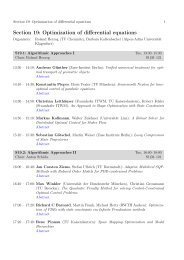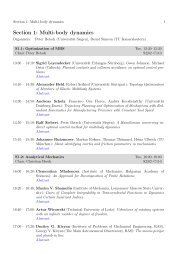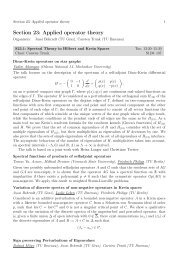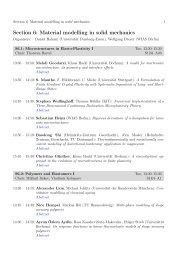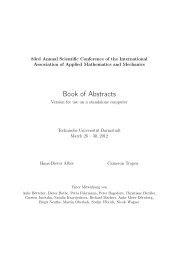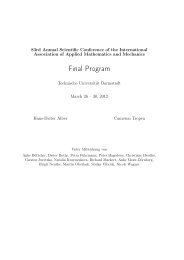Section 6: Material modelling in solid mechanics - GAMM 2012
Section 6: Material modelling in solid mechanics - GAMM 2012
Section 6: Material modelling in solid mechanics - GAMM 2012
You also want an ePaper? Increase the reach of your titles
YUMPU automatically turns print PDFs into web optimized ePapers that Google loves.
<strong>Section</strong> 6: <strong>Material</strong> <strong>modell<strong>in</strong>g</strong> <strong>in</strong> <strong>solid</strong> <strong>mechanics</strong> 21<br />
elements should usually be preferred. Therefore, we use a <strong>solid</strong>-shell element presented by Schwarze<br />
and Reese [2] which comb<strong>in</strong>es the advantages of both <strong>solid</strong> elements and shell elements at the<br />
same time. This element allows for display<strong>in</strong>g realistically the three-dimensional geometry while<br />
still provid<strong>in</strong>g the suitable shape for th<strong>in</strong> structures.<br />
In addition, the present <strong>solid</strong>-shell formulation utilizes a reduced <strong>in</strong>tegration scheme with<strong>in</strong> the<br />
shell plane us<strong>in</strong>g one <strong>in</strong>tegration po<strong>in</strong>t, whereas a full <strong>in</strong>tegration is used <strong>in</strong> thickness direction.<br />
Thus, an arbitrary number of <strong>in</strong>tegration po<strong>in</strong>ts can be chosen over the shell thickness. Thereby,<br />
different fibre orientations of the layers can be taken <strong>in</strong>to account easily, s<strong>in</strong>ce the material<br />
parameters can be def<strong>in</strong>ed for each <strong>in</strong>tegration po<strong>in</strong>t separately.<br />
Moreover, the proposed <strong>solid</strong>-shell formulation removes all potential lock<strong>in</strong>g phenomena. In<br />
particular, volumetric lock<strong>in</strong>g <strong>in</strong> case of (nearly) <strong>in</strong>compressible materials as well as Poisson<br />
thickness lock<strong>in</strong>g <strong>in</strong> bend<strong>in</strong>g problems of shell-like structures are elim<strong>in</strong>ated by use of the enhanced<br />
assumed stra<strong>in</strong> (EAS) concept. In addition, to cure the transverse shear lock<strong>in</strong>g which is present<br />
<strong>in</strong> standard eight-node hexahedral elements, the assumed natural stra<strong>in</strong> (ANS) method is applied.<br />
[1] S. Reese. A micromechanically motivated material model for the thermo-viscoelastic material<br />
behaviour of rubber-like polymers, Int J Plast, 19, 909–940, 2003.<br />
[2] M. Schwarze, S. Reese. A reduced <strong>in</strong>tegration <strong>solid</strong>-shell f<strong>in</strong>ite element based on the EAS and<br />
the ANS concept - large deformation problems, Int J Numer Methods Engng, 85, 289–329,<br />
2011.<br />
On consistent tangent operator derivation and comparative study of rubber-like material<br />
models at f<strong>in</strong>ite stra<strong>in</strong>s<br />
Mokarram Hossa<strong>in</strong>, Paul Ste<strong>in</strong>mann (Universität Erlangen-Nürnberg)<br />
The overall micro-structure of rubber-like materials can be idealized by cha<strong>in</strong>-like macromolecules<br />
which are connected to each other at certa<strong>in</strong> po<strong>in</strong>ts via entanglements or cross-l<strong>in</strong>ks. Such<br />
special structure leads to a completely random three-dimensional network [2,3]. To model the<br />
mechanical behaviour of such randomly-oriented micro-structure, several phenomenological and<br />
micro-mechanically motivated network models for nearly <strong>in</strong>compressible hyperelastic polymeric<br />
materials have been proposed <strong>in</strong> the literature. To implement these models for polymeric material<br />
(undoubtedly with widespread eng<strong>in</strong>eer<strong>in</strong>g applications) <strong>in</strong> f<strong>in</strong>ite element method, one would<br />
require two important <strong>in</strong>gredients, e.g. the stress tensor and the consistent fourth-order tangent<br />
operator where the latter is the result of l<strong>in</strong>earization of the former.<br />
In this contribution, an extensive overview on several hyperelastic rubber-like material models<br />
has been presented. Special focus is given particularly to derive the accurate stress tensors and<br />
tangent operators which yield quadratic convergence when the govern<strong>in</strong>g nonl<strong>in</strong>ear equations for<br />
a boundary value problem are solved by the Newton-like iterative schemes. A simple but efficient<br />
algorithm will be demonstrated to testify the correctness of the tangent operator locally of a<br />
particular model without go<strong>in</strong>g <strong>in</strong>to details of the f<strong>in</strong>ite element implementation [1].<br />
[1] Ste<strong>in</strong>mann P, Hossa<strong>in</strong> M, Possart G (2011), Hyperelastic models for rubber-like materials:<br />
Consistent tangent operators and suitability for Treloar’s data. Archive of Applied Mechanics,<br />
In review (2011)<br />
[2] Boyce MC, Arruda EM (2000), Constitutive models of rubber elasticity: a review. Rubber<br />
Chemistry and Technology, 73: 504-523, 2000



